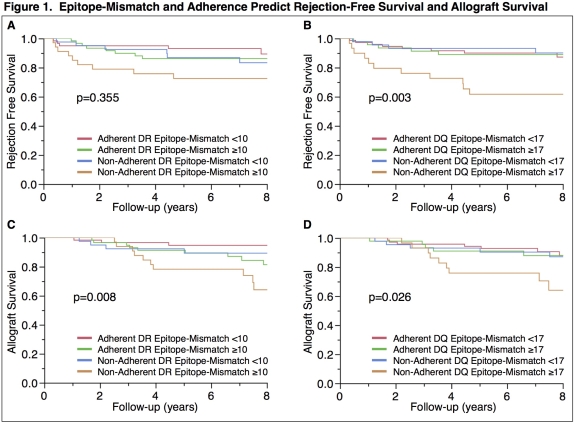The Synergistic Effect of Class II HLA Epitope-Mismatch and Non-Adherence on Acute Rejection and Graft Survival
1Medicine, University of Manitoba, Winnipeg, MB, Canada
2Transplant Immunology, Diagnostic Services of Manitoba, Winnipeg, MB, Canada
3Pediatrics, University of Minnesota, Minneapolis, MN
4Medicine, University of Minnesota, Minneapolis, MN
5Public Health, University of Minnesota, Minneapolis, MN
6Surgery, University of Minnesota, Minneapolis, MN
7Immunology, University of Manitoba, Winnipeg, MB, Canada.
Meeting: 2015 American Transplant Congress
Abstract number: B100
Keywords: Epitopes, HLA matching, Renal failure
Session Information
Session Name: Poster Session B: Kidney Complications: Late Graft Failure
Session Type: Poster Session
Date: Sunday, May 3, 2015
Session Time: 5:30pm-6:30pm
 Presentation Time: 5:30pm-6:30pm
Presentation Time: 5:30pm-6:30pm
Location: Exhibit Hall E
Predicting long-term outcomes in renal transplant recipients is essential to optimize medical therapy and determine the frequency of post-transplant pathologic and serologic monitoring. Non-adherence and HLA mismatch are risk factors that have been associated with poor long-term outcomes and may help individualize care. In the present study class II HLA mismatches were determined at the HLA epitope level in 195 renal transplant recipients in whom medication adherence was prospectively measured using electronic monitors in medication vial caps. Recipients were grouped by medication adherence and high (≥10 HLA-DR, ≥17 HLA-DQ) or low epitope-mismatch load. We found that the combination of higher epitope mismatch and poor adherence acted synergistically to determine the risk of rejection or graft loss. Non-adherent recipients with HLA-DR epitope mismatch ≥10 had increased graft loss (35% vs. 8%, p<0.01) compared to adherent recipients with low epitope mismatch. At the HLA-DQ locus non-adherent recipients with HLA-DQ epitope mismatch ≥17 had increased graft loss (33% vs. 10%, p<0.01) compared to adherent recipients with low epitope mismatch. Subclinical non-adherence early post-transplant combined with HLA class II epitope mismatch may help identify recipients that could benefit from increased clinical, pathologic, and serologic monitoring.
Non-adherent recipients with HLA-DR epitope mismatch ≥10 had increased graft loss (35% vs. 8%, p<0.01) compared to adherent recipients with low epitope mismatch. At the HLA-DQ locus non-adherent recipients with HLA-DQ epitope mismatch ≥17 had increased graft loss (33% vs. 10%, p<0.01) compared to adherent recipients with low epitope mismatch. Subclinical non-adherence early post-transplant combined with HLA class II epitope mismatch may help identify recipients that could benefit from increased clinical, pathologic, and serologic monitoring.
To cite this abstract in AMA style:
Wiebe C, Nevins T, Robiner W, Thomas W, Matas A, Nickerson P. The Synergistic Effect of Class II HLA Epitope-Mismatch and Non-Adherence on Acute Rejection and Graft Survival [abstract]. Am J Transplant. 2015; 15 (suppl 3). https://atcmeetingabstracts.com/abstract/the-synergistic-effect-of-class-ii-hla-epitope-mismatch-and-non-adherence-on-acute-rejection-and-graft-survival/. Accessed December 18, 2025.« Back to 2015 American Transplant Congress
